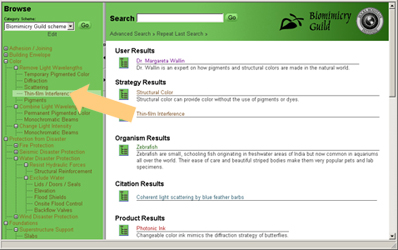In 2004, this wireframe information architecture was the first version of what is now AskNature.org, the online database to help engineers, designers, and other creators to find biological ideas, knowledge, and experts.
Linked Search & Browse: The novel information architecture was to link searching and browsing for more effective discovery. A taxonomy is always displayed in the left sidebar; when a search is done and the list of search hits displays in the main window, clicking on a search hit automatically expands the taxonomy in the sidebar to highlight the item. This shows what other items are in its same category, even if they do not share keywords, and shows the user what higher-level categories provide adjacent ideas. This helps users find things they do not know the words for, or search across discipline boundaries.

Other Features:
Searchable Relational Database: more specific searches are possible than in wikis or normal websites.
Browsable: The database does not attempt to decree one universal taxonomy, like most systems. It also does avoids the pitfalls of many “folksonomies” or tag systems, which average away individual insights. It recognizes that different users will understand different schemes, and in fact users can create their own category schemes. This will allow users to not just find information, but organize it, and even help researchers expose gaps in existing knowledge. It also allows translation across taxonomies, by browsing in one taxonomy, clicking on a record, then switching taxonomies to see where the record appears in the new taxonomy.

Modularity and Interrelation: Records are split into challenges, strategies, people, organisms, products, and citations. Records are connected to each other through category schemes and permanent links.
Interactivity / Collaboration: Records include space for comments, which can become bulletin-boards for discussion; qualified users can also add, edit, and link records like a wiki. Records added by users are flagged as “Not Yet Reviewed” until a qualified administrator reviews them for scientific accuracy. Each user has their own page, which they can use to blog research or ideas.

The novel structure of this system would make it a useful tool for any cross-disciplinary knowledge portal.

